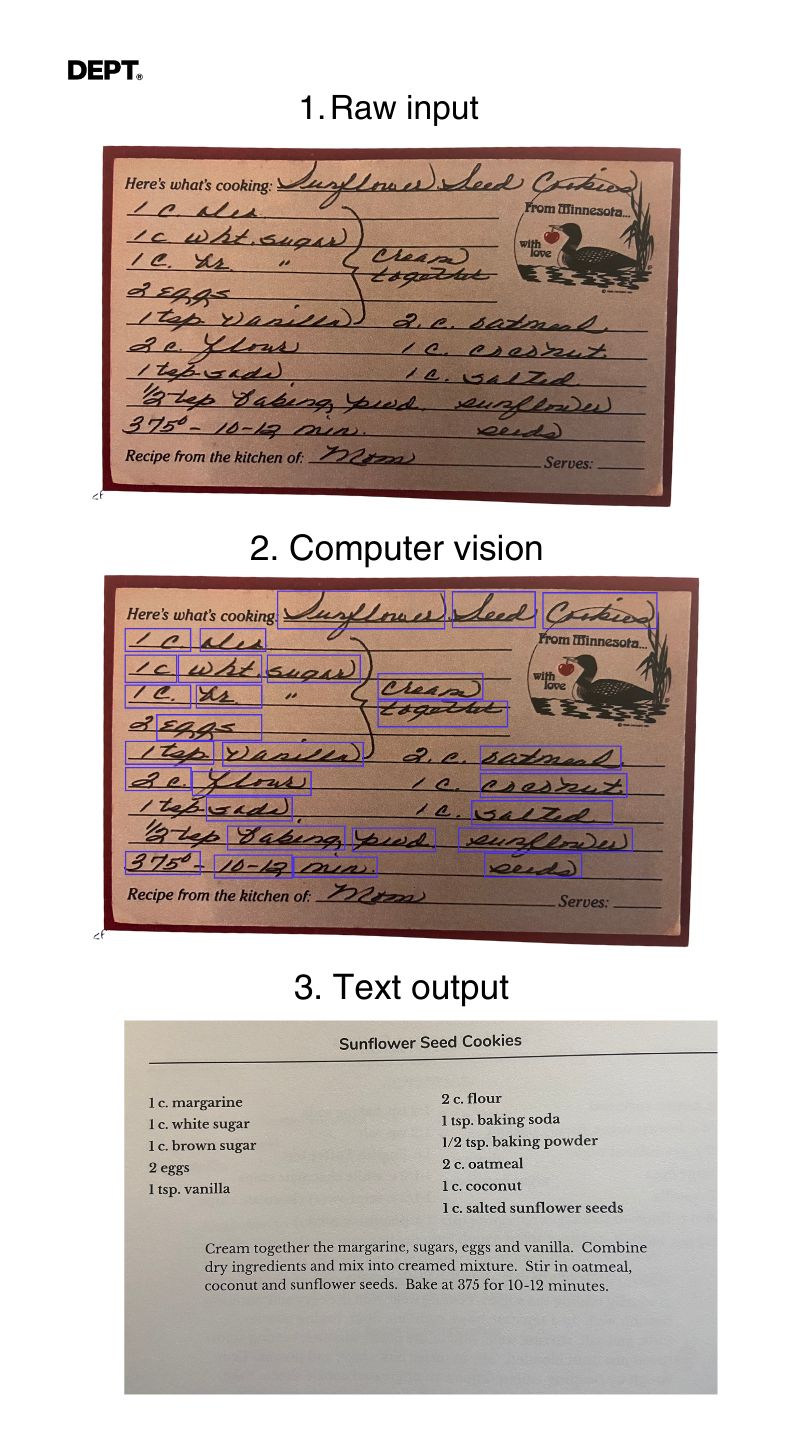At the beginning of the year, we explored artificial intelligence’s impact across various specialties and functions. And while the “design and content revolution!” appears in more headlines, AI is also accelerating product development.
We know this firsthand. Since generative AI collided with our industry last winter, our teams have been experimenting–sometimes with delight, sometimes with skepticism–with ChatGPT, Copilot, and various other AI tools.
Many opportunities exist to leverage generative AI across the product lifecycle, including discovery, strategy, design, development, and ongoing support. Here’s where we’ve seen the greatest promise.
Generative AI in product innovation
Introducing generative AI capabilities to the public has undoubtedly helped our product teams integrate and build new, innovative features.
For example, we recently built a prototype for transforming written words into digital content. We explored leveraging OCR (optical character recognition) as part of its product strategy.
Rather than develop our own proprietary OCR product, we identified a third-party “off-the-shelf” tool for consumer OCR. We paired this character recognition tool with a self-managed LLM and other productivity apps to streamline common workflows.

The final product idea allows users to transcribe and transfer their written text into commonly used digital tools. Or, in the visual example above, memorialize grandma’s recipes in a cookbook.
Without generative AI, this product would be a non-starter. Fortunately for the team, it could go into development at any moment.
The ability to experiment with AI and open-source AI tools unquestionably has the power to help product teams innovate. Just be warned: an untested product feature can quickly go rogue.
Generative AI in product experience & design
Perhaps obvious, but ChatGPT is a fantastic tool for understanding user feedback. Your user research team can train ChatGPT to recognize patterns in feedback and provide insights on what users say about a prototype, product, or design. The process is pretty simple:
- Collect user feedback: This can be done through surveys, interviews, or other feedback channels.
- Input feedback into ChatGPT: ChatGPT can be trained to recognize sentiment, keywords, and phrases related to specific aspects of a product or design, such as usability, functionality, or aesthetics.
- Analyze feedback: ChatGPT can help you analyze the user feedback and provide insights into what users say about the product or design. For example, ChatGPT can identify common issues or pain points that users are experiencing or highlight areas where users are particularly satisfied.
Based on the insights, you can streamline the feedback loop and meet user needs faster.
Going a step further, you can also leverage generative AI to assist your team in collecting this feedback. For many teams, creating a chatbot that simulates a conversation with a user about a specific product or design is worthwhile. A strategist could run 100 user tests with 100 virtual users in minutes. This capability will only improve, too. As of writing this, OpenAI rolled out the ability to see, hear, and speak.
Earlier this year, one of our product teams built a NetSuite/Slack support bot with ChatGPT 4, dramatically reducing the response time for queries and allowing NetSuite admins to focus on more complex issues. Learn more about the process of creating this support bot.
And, of course, generative AI is becoming increasingly pervasive in design tools. While AI capabilities haven’t quite caught up to user interface design, its ability to create custom stock images, 3D renderings, and unique product imagery helps designers visualize outcomes faster.
Generative AI in product development
Particularly in development, generative AI has been explored for its potential to automate coding tasks that are time-intensive but uncreative.
With hundreds of developers across DEPT®, some have embraced its usefulness more than others, but generally speaking, we don’t see generative AI as a game changer in development–yet. However, we are seeing shortened cycles for some time-consuming tasks. These mostly include brainstorming and generating boilerplate code.
Brainstorming
“I mainly use it when I’m stuck on a problem and need to brainstorm alternate solutions. I only use it if I know I can validate the solution immediately (e.g., run the code and it works as expected) instead of using it as a building block, and it falls down because it didn’t work as expected. Since the knowledge base is a couple of years old, it’s not reliable for current info like API details.”
Ashwin Sundar, Senior Engineer
Generating boilerplate code
“The most helpful thing I’ve seen it do is create boilerplate integration code (if you need to integrate with a database or API). There are definitely best practices around this kind of code, and ChatGPT generates it well.
Generally, it’s more useful for greenfield development. If you’re trying to jam new code into legacy code with dependency, it’s not as smooth.”
Matt Merrill, Director of Engineering
Looking ahead to Copilot
“You spend more time reading code than writing code” is a common catchphrase among engineers. And one of Copilot’s offerings is the ability to read and summarize existing code for developers in a new codebase.
After testing Copilot in the fall of 2023, we found it good at explaining individual lines of code or high-level overviews of a single file, but it fails to explain an entire codebase. It tries, but the scope of analysis seems to be limited to a single file.
We hope this gets better because the ability to understand a new codebase would save hours of time getting up to speed between projects.
Diving in while playing it (reasonably) safe
“Putting too much faith in AI algorithms is risky, especially considering their known biases and relative infancy,” said Matt Merrill, Director of Engineering at DEPT®.
That being said, we are thrilled at many breakthroughs in generative AI and are constantly exploring new ways to understand users, be more creative, and reduce monotonous tasks.
Reach out to our Digital Products team to learn more about accelerating product development.





